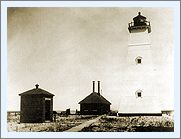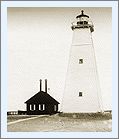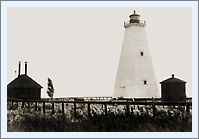|
Historical
Information

At the dawn of the final decade of the nineteenth century,
three passages had been developed for maritime traffic making between
the Straits of Mackinac and Green Bay, with the route selected by
mariners dependent on weather conditions and final destination. The
North Passage led almost directly west out of the Straits, guided by
lightship LV56 on White Shoal and the coast lights on Squaw Island and
Seul Choix. The central route passed between the lights on North Fox and
Beaver Island, and the third passage led between North Manitou and South
Fox. While the light station on South Fox had served to mark the north
side of the passage since 1867, without a light in North Manitou Island,
the southern boundary of this 17 mile wide passage was as yet unmarked.
In view of the immense trade passing through the area, the Lighthouse
Board recommended in its annual report for 1892 that Congress make an
appropriation of $20,000 to establish a light and fog signal on the
north shore of North Manitou Island to adequately light both sides of
the passage.
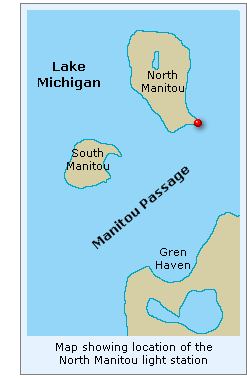 While Congress passed an act approving the
establishment of the new station on February 15, 1893, it neglected to
follow up with an appropriation for the necessary funding, and the Board
reiterated its request in its two following reports. Congress finally
appropriated funding on March 2, 1895, and a survey party was dispatched
to the island to select an appropriate site. While the Board's
recommendations clearly stated that the new light should be established
on the north shore of the island, for reasons we have yet been unable to
determine, a site on the island's southernmost prominence known to
islanders as "Dimmick's Point" was instead selected for the
station, and negotiations to obtain title to the selected site were
undertaken immediately. However, the owner of the selected was evidently
unwilling to sell, and condemnation proceedings were initiated by the US
Attorney in September, 1895. While Congress passed an act approving the
establishment of the new station on February 15, 1893, it neglected to
follow up with an appropriation for the necessary funding, and the Board
reiterated its request in its two following reports. Congress finally
appropriated funding on March 2, 1895, and a survey party was dispatched
to the island to select an appropriate site. While the Board's
recommendations clearly stated that the new light should be established
on the north shore of the island, for reasons we have yet been unable to
determine, a site on the island's southernmost prominence known to
islanders as "Dimmick's Point" was instead selected for the
station, and negotiations to obtain title to the selected site were
undertaken immediately. However, the owner of the selected was evidently
unwilling to sell, and condemnation proceedings were initiated by the US
Attorney in September, 1895.
Plans and specifications were drawn up for duplicate
fog-signal boilers and machinery that winter, and bids opened for
supplying the equipment on April 15, 1896. The contract for supplying
the machinery was awarded to Kingsford Foundry & Machine Works in
Oswego, New York, who began work on the equipment immediately. Work then
began on planning the station structures. Rather than create a new set
of plans for the dwelling and fog signal building, Ninth District
Engineer Milton B. Adams apparently decided to use plans that had been
developed for similar structures the previous year on Plum Island across
Lake Michigan.
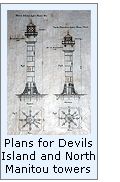 In 1896, Major Adams was serving as Chief Engineer in
both the Ninth and Eleventh Districts, and was already working on a
design for a radical new type of cylindrical iron tower for
incorporation into new stations planned at the entrance to Sturgeon Bay
Canal on the west shore of lake Michigan and at Devils Island on the
south shore of Lake Superior. These new towers consisted of a simple
iron cylinder, and were designed to be largely self supporting, the
central cylinder served both as the primary support for the light as
well as a housing for the spiral stairway contained within. Thus,
initial plans for North Manitou station included a tower of similar
design. In 1896, Major Adams was serving as Chief Engineer in
both the Ninth and Eleventh Districts, and was already working on a
design for a radical new type of cylindrical iron tower for
incorporation into new stations planned at the entrance to Sturgeon Bay
Canal on the west shore of lake Michigan and at Devils Island on the
south shore of Lake Superior. These new towers consisted of a simple
iron cylinder, and were designed to be largely self supporting, the
central cylinder served both as the primary support for the light as
well as a housing for the spiral stairway contained within. Thus,
initial plans for North Manitou station included a tower of similar
design.
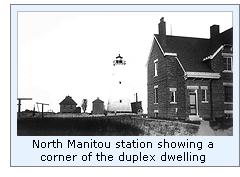 The contractors began work on the station structures
in August, 1896 with work progressing quickly. The red brick fog signal
building stood 40' 1" in length, 22' 6" wide, and its walls
12' 6" in height at the eaves, supporting a hipped roof sheathed
with corrugated iron. The two-story dwelling, also of red brick, was
erected over a full cellar with walls of cut limestone, and was capped
by a red-painted tin shingle roof. The interior of the structure was
configured as three separate living quarters, with the Keeper occupying
both floors in the south half of the building, the First Assistant the
first floor of the north half and the Second Assistant a similar area on
the second floor immediately above. Entrance to the keepers quarters was
gained through a door on one side of the dwelling, with the Assistants
sharing a door on the opposite side. The interior of the building was
universally accepted as being the most opulent ever built on the island,
with entry foyer floors laid with ceramic tile and fine varnished oak
millwork throughout. All quarters featured built-in oak cabinetry
including glass-fronted china cabinets in the dining rooms. The Keepers
quarters even featured pressed tin ceilings in the parlor and dining
room. With the erection of a pair of privies, work on the dwelling was
considered complete. The contractors began work on the station structures
in August, 1896 with work progressing quickly. The red brick fog signal
building stood 40' 1" in length, 22' 6" wide, and its walls
12' 6" in height at the eaves, supporting a hipped roof sheathed
with corrugated iron. The two-story dwelling, also of red brick, was
erected over a full cellar with walls of cut limestone, and was capped
by a red-painted tin shingle roof. The interior of the structure was
configured as three separate living quarters, with the Keeper occupying
both floors in the south half of the building, the First Assistant the
first floor of the north half and the Second Assistant a similar area on
the second floor immediately above. Entrance to the keepers quarters was
gained through a door on one side of the dwelling, with the Assistants
sharing a door on the opposite side. The interior of the building was
universally accepted as being the most opulent ever built on the island,
with entry foyer floors laid with ceramic tile and fine varnished oak
millwork throughout. All quarters featured built-in oak cabinetry
including glass-fronted china cabinets in the dining rooms. The Keepers
quarters even featured pressed tin ceilings in the parlor and dining
room. With the erection of a pair of privies, work on the dwelling was
considered complete.
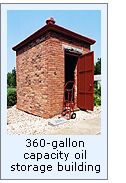 Work on the fog signal building was completed in
October, just in time for the arrival of the lighthouse tender AMARANTH
with the necessary fog signal equipment. Over the following month, twin
marine boilers were secured to concrete pads which had been prepared
prior to their arrival. Each horizontal marine boiler was equipped with
4" diameter horizontal cylinders with a stroke of 9", designed
to provide an operating steam pressure of 90 pounds per square inch.
Each of the engines was plumbed to its own 10" whistle mounted atop
the roof, and the boilers piped to a pair of 20" diameter steel
chimneys rising through the roof to a total height of 32' 4" above
the foundation. Installation of the north signal was completed and the
unit tested and placed into operation on November 20th, 1896. A 6' by 6'
red brick 360-gallon capacity oil house and a 16' 4" by 36' 4"
buff-painted board and batten boathouse completed the complement of
station buildings. Construction at the station was completed in
December, just in time for the crew to depart with the onset of winter. Work on the fog signal building was completed in
October, just in time for the arrival of the lighthouse tender AMARANTH
with the necessary fog signal equipment. Over the following month, twin
marine boilers were secured to concrete pads which had been prepared
prior to their arrival. Each horizontal marine boiler was equipped with
4" diameter horizontal cylinders with a stroke of 9", designed
to provide an operating steam pressure of 90 pounds per square inch.
Each of the engines was plumbed to its own 10" whistle mounted atop
the roof, and the boilers piped to a pair of 20" diameter steel
chimneys rising through the roof to a total height of 32' 4" above
the foundation. Installation of the north signal was completed and the
unit tested and placed into operation on November 20th, 1896. A 6' by 6'
red brick 360-gallon capacity oil house and a 16' 4" by 36' 4"
buff-painted board and batten boathouse completed the complement of
station buildings. Construction at the station was completed in
December, just in time for the crew to depart with the onset of winter.
For reasons that we have yet to determine, plans for
erecting the planned iron tower at the station stalled in 1897. Whether
it was a result of vibration problems being experienced with the similar
tower at the Sturgeons Bay Canal
station, or a lack of sufficient funds
remaining from the appropriation, the North Manitou light station was
operated as a fog signal station only during the 1897 navigation season.
Late that year, plans for the iron tower were abandoned, and the
decision was made to erect a timber pyramid tower at the station, and
contracts was awarded for furnishing the required materials and a
circular Fourth order lantern.
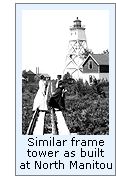 A work crew again arrived at North Manitou in July,
1989 and began work by leveling the selected tower site and erected
eight concrete pads which would serve as the structure's foundation. On
these pads, the framing of the tower was erected using 14" square
timbers. The pyramidal open frame timber structure stood 24' 8" square at the
base and tapered to 10' 4" beneath the gallery. The upper level of
the structure was enclosed with clapboards to cerate a service room in
which to clean lamps and store supplies. A square southern
white pine gallery 14' square was installed above the service room, and a
circular lantern 7' 8" in diameter with diagonal astragals erected
at its center. The district Lampist arrived at the station, and
carefully uncrated the station's new Fourth Order Fresnel lens which had
been manufactured in Paris in 1896 by L. Sautter et Cie., and shipped to
the station by way of the central depot in Staten Island and the
district depot in Detroit. After the components were carefully carried
into the lantern, the lens was assembled on a 20-ball bearing raceway
atop the pedestal. Designed to exhibit an alternating red and white
flashes every ten seconds, the six panel lens was outfitted bulls eyes
on each panel. Power for rotating the lens was provided by a fan
regulated clockwork mechanism connected to the lens by a series of
gears. A steel cable was wound around a drum within the clockworks, with
the cable routed through the lantern floor and around a pulley and
thence vertically within the open structure of the tower interior, and a
heavy weight attached to the lower end of the cable. This weight slowly
dropped down, turning the drum, and thereby rotating the lens. Ruby
glass panels were fitted to the outside of the lens to impart the
alternating red flashes, The new light was exhibited for the first time
on the evening of September 15, 1898, and by virtue of the tower's
location atop a slight rise, the lens sat at a focal plane of 70 feet
above lake level, and was visible for a distance of 16 miles in clear
weather. A work crew again arrived at North Manitou in July,
1989 and began work by leveling the selected tower site and erected
eight concrete pads which would serve as the structure's foundation. On
these pads, the framing of the tower was erected using 14" square
timbers. The pyramidal open frame timber structure stood 24' 8" square at the
base and tapered to 10' 4" beneath the gallery. The upper level of
the structure was enclosed with clapboards to cerate a service room in
which to clean lamps and store supplies. A square southern
white pine gallery 14' square was installed above the service room, and a
circular lantern 7' 8" in diameter with diagonal astragals erected
at its center. The district Lampist arrived at the station, and
carefully uncrated the station's new Fourth Order Fresnel lens which had
been manufactured in Paris in 1896 by L. Sautter et Cie., and shipped to
the station by way of the central depot in Staten Island and the
district depot in Detroit. After the components were carefully carried
into the lantern, the lens was assembled on a 20-ball bearing raceway
atop the pedestal. Designed to exhibit an alternating red and white
flashes every ten seconds, the six panel lens was outfitted bulls eyes
on each panel. Power for rotating the lens was provided by a fan
regulated clockwork mechanism connected to the lens by a series of
gears. A steel cable was wound around a drum within the clockworks, with
the cable routed through the lantern floor and around a pulley and
thence vertically within the open structure of the tower interior, and a
heavy weight attached to the lower end of the cable. This weight slowly
dropped down, turning the drum, and thereby rotating the lens. Ruby
glass panels were fitted to the outside of the lens to impart the
alternating red flashes, The new light was exhibited for the first time
on the evening of September 15, 1898, and by virtue of the tower's
location atop a slight rise, the lens sat at a focal plane of 70 feet
above lake level, and was visible for a distance of 16 miles in clear
weather.
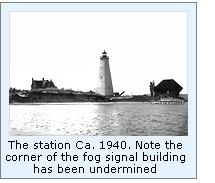 In the summer of 1899, the lighthouse tender AMARANTH
returned to the station with a working party and materials to complete
the station. After sheathing the entire exterior of the skeleton frame
tower with clapboards, a lightning conductor of 3/16" by 1 ½"
copper was attached to the lantern, and stapled down the clapboards to
the ground, where it was buried deeply enough to contact moist ground.
The boat landing was extended an additional 55 feet, 644 feet of plank
walks were laid from the dwelling to the boathouse, and a 60 foot flag
pole erected in the middle of the station grounds. 1899 was likely a
memorable year for the North Manitou keepers, as they fed 88 cords of
wood into the hungry fog signal boilers to keep the whistle screaming
its warning across the Manitou Passage for a station record 757 hours. In the summer of 1899, the lighthouse tender AMARANTH
returned to the station with a working party and materials to complete
the station. After sheathing the entire exterior of the skeleton frame
tower with clapboards, a lightning conductor of 3/16" by 1 ½"
copper was attached to the lantern, and stapled down the clapboards to
the ground, where it was buried deeply enough to contact moist ground.
The boat landing was extended an additional 55 feet, 644 feet of plank
walks were laid from the dwelling to the boathouse, and a 60 foot flag
pole erected in the middle of the station grounds. 1899 was likely a
memorable year for the North Manitou keepers, as they fed 88 cords of
wood into the hungry fog signal boilers to keep the whistle screaming
its warning across the Manitou Passage for a station record 757 hours.
Judgment was finally rendered in the District Court
for the condemnation of the lighthouse site on January 23, 1899, and
with a fair value of $487.41 determined for the property, a like sum was
deposited by the Government with the Clerk of the court on February 25.
The following year, the boathouse was moved to the opposite side of the
Dimmick's Point and a new plank walked laid to the dwelling. While on
site, the crew also erected a 24' by 28' foot timber-framed barn and a
woodshed before the crew departed for work elsewhere. Three years later,
the plank walkways within the fenced-in section of the station were
replaced by 641 feet of concrete paths and a new landing was placed
beside the boathouse.
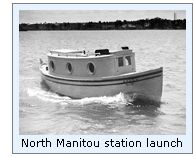 Life at the isolated station was not without its
hazards, as witnessed by a close call that Keeper Edward Cornell
experienced in 1910. It would appear that the gas tank in the keeper's
boat developed a leak, and forced to make repairs at the station,
Cornell decided to solder the leaking seam. Unaware that the tank still
contained a residual amount of gasoline, the blowtorch he was using for
soldering ignited the fumes, resulting in a huge explosion which set
fire to the boat, fracturing the bones in his right ankle. Mustering a
Herculean effort from within his fog of pain, Cornell managed to
extinguish the fire around him before dragging himself onto the landing.
While after Cornell was taken to the doctor in Leeland he managed to
continue his duties with the aid of crutches, it was months before he
fully recovered the use of his right ankle. Also that year, with the
completion of the new light at White Shoal, lightship LV56 was moved to
mark the southern limit of North Manitou Shoal. With the lightship now
marking the north side of the passage, the days of viability for the
North Manitou station were inevitably numbered. Life at the isolated station was not without its
hazards, as witnessed by a close call that Keeper Edward Cornell
experienced in 1910. It would appear that the gas tank in the keeper's
boat developed a leak, and forced to make repairs at the station,
Cornell decided to solder the leaking seam. Unaware that the tank still
contained a residual amount of gasoline, the blowtorch he was using for
soldering ignited the fumes, resulting in a huge explosion which set
fire to the boat, fracturing the bones in his right ankle. Mustering a
Herculean effort from within his fog of pain, Cornell managed to
extinguish the fire around him before dragging himself onto the landing.
While after Cornell was taken to the doctor in Leeland he managed to
continue his duties with the aid of crutches, it was months before he
fully recovered the use of his right ankle. Also that year, with the
completion of the new light at White Shoal, lightship LV56 was moved to
mark the southern limit of North Manitou Shoal. With the lightship now
marking the north side of the passage, the days of viability for the
North Manitou station were inevitably numbered.
Waves driven by stiff offshore winds frequently dashed
their way across Dimmick's Point, and the keepers had grown used to lake
water moving close to the station at times. However in 1912, currents
and wave action became so strong that they found water lapping at the
foundations of the fog signal building. After learning of the news in
Detroit, am engineer and construction crew was dispatched to North
Manitou and five spur cribs were erected to help stabilize the eroding
shoreline. Apparently, the cribs served their function, as sand quickly
began to accumulate up in the lee of the cribs, and by the end of the
year there was a full fifty feet of beach restored between the station
buildings and the water's edge. On April 24, 1916, the station's oil
lamp was replaced with an incandescent oil vapor system, which increased
the intensity of the white light to 24,000 candlepower and the red flash
to 7,200 candlepower.
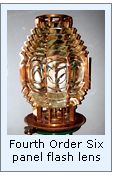 The light was automated in 1928 through the
installation of sun valve equipped acetylene-powered light. However,
with the establishment of the North Manitou Shoal Light to replace the
lightship in 1935, the North Manitou Light station had outlived its
purpose, and the acetylene light was discontinued. The entire lighthouse
property was subsequently declared surplus and sold at auction to
Lansing businessman William Angell for $2,600 in October, 1938. The light was automated in 1928 through the
installation of sun valve equipped acetylene-powered light. However,
with the establishment of the North Manitou Shoal Light to replace the
lightship in 1935, the North Manitou Light station had outlived its
purpose, and the acetylene light was discontinued. The entire lighthouse
property was subsequently declared surplus and sold at auction to
Lansing businessman William Angell for $2,600 in October, 1938.
Without constant painting by crew of dedicated
keepers, the wooden tower and out buildings quickly faded from their
crisp white appearance to a dull silvery-gray, and without continued
shore protection, the waves began to reclaim an increasingly large
expanse of beach in front of the station. Before long, the water was
again lapping at the foundation piers of the tower, and thus
compromised, the tower crashed to the ground in October, 1942.
After twenty years of unabated erosion, the waves
finally began lapping against the lakeward side of the empty dwelling.
With more and more of the foundation this being undermined, the lakeward
wall collapsed in 1968, leaving the interior floors exposed like a
doll's house. The interior of the structure completely exposed to the
elements, decay was rapid, and the remainder of the once majestic
structure came crashing down in the 1970's

Keepers of
this Light

Click here
to see a complete listing of North Manitou Island keepers compiled by Phyllis L. Tag of Great Lakes Lighthouse Research.

Finding this Light

While the only visible remains of the station are the ruins of
the privies and barn, visitors to North Manitou are rewarded with
incredible solitude and beauty. All of North Manitou Island is now part
of the Sleeping Bear National Lakeshore. Boat trips to North Manitou
Island leave the docks in Leland throughout the summer. Since there is
no transportation, food or lodging of any kind on the island, visitors
will have to carry everything needed for an overnight stay, and a
4 1/2 mile hike to Dimmick's Point from the boat landing. As a result of
nesting on the dunes around Dimmick's Point, the area is off limits to
all hiking before August every year. For more information, contact:
Manitou Island Transit Company.
PO Box 591
Leland, MI 49654
Telephone (231) 256-9061
Or click here to
visit their websites

Reference Sources

Annual reports of the
Lighthouse Board, various, 1892 - 1909
Annual reports of the Lighthouse Service, various, 1910 - 1920
Annual reports of the Lake Carriers Association, various, 1909 - 1935
Great Lakes Light Lists, various, 1901 - 1938
North Manitou ISland, Between Sunrise and Sunset, Rita Hadra Rusco,
1991
Exploring North Manitou, South Manitou, High & Garden Islands, Robert
H Ruchcroft, 1991
Keeper listings for this light appear courtesy of Great Lakes Lighthouse
Research
|
